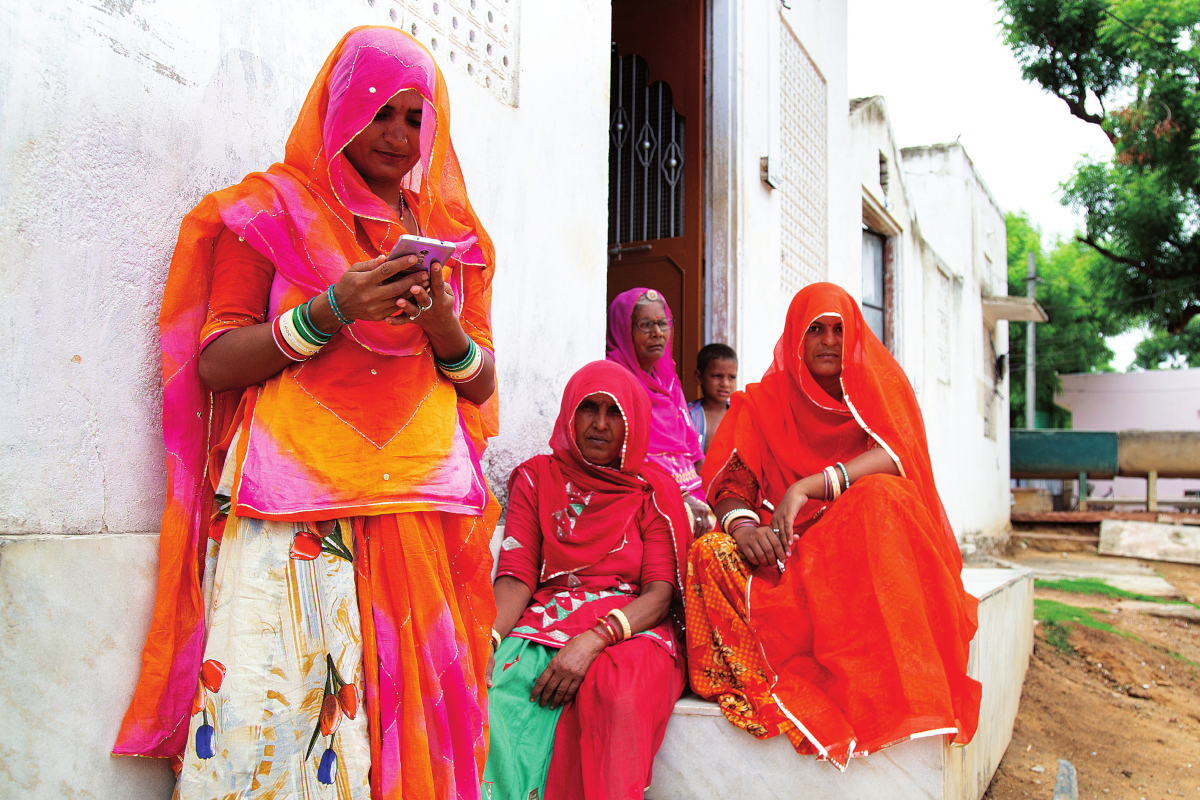After a long day at work, 38-year-old Jainam Shukla would often look for ways to unwind — meet friends at the street corner, mindlessly browse social media or just stay bored at home! His wife Poonam and eight-year-old daughter Shikha would be busy watching television, but the shows did not interest him. As a security guard at a private company in Sinhasa, a small town in Indore district, he could not afford a Netflix or Hotstar subscription.
But over the past two months, Shukla has found a new entertainment — a gaming app called Hello Play. On it, he plays carrom and snakes and ladders, and the app interacts in his native language, Hindi. Needless to say, he is hooked.
There are millions like Shukla and, to cater to this crowd, many start-ups have come up with platforms that ‘speak’ in regional languages. There are video news platforms such as Awaaz India and Dailyhunt, information portal Vokal, social media platforms ShareChat and Khidki, and language-as-a-service (LaaS) firm Reverie. It doesn’t end there. The list is long and impressive.
Gunning for growth
What’s more impressive is that these start-ups have already caught the interest of several private equity and venture capital firms (See: Surge in interest). According to Nandan Venkatachalam, investment manager at Axilor Ventures, there are four trends playing out — “Integrating dialects, increase in regional commerce, local/regional advertising and usage of deep tech for content curation.”
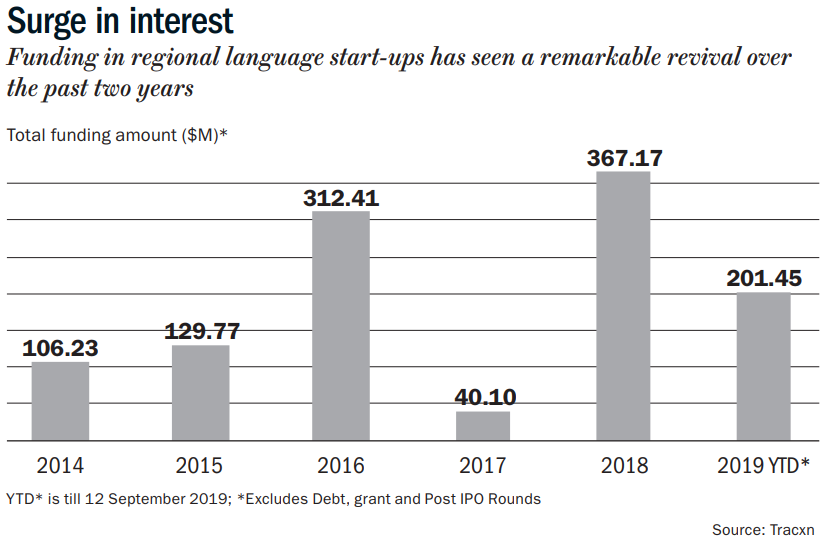
These are riding on the unbelievable increase in internet usage. A recent RedSeer study titled Vernacular is NOW, not the future notes that the number of internet users in the country has touched 530 million, at a run rate of 65 million per year over the past two years. An incredible leap from adding just 8 million users per year from 2000-2009. By 2023, we are expected to have 850 million logged in. “The number of monetisable users, based on consumption power, is expected to rise from 260 million in 2018 to 400 million in 2023,” says Ujjwal Chaudhry, director, RedSeer Consulting.
Cheap smartphones and data, first from the onslaught of Chinese phone manufacturers and the latter with the launch of Jio, have made this happen. RedSeer’s report adds that data costs fell by 93% after Jio, improving both accessibility and affordability. People such as Mohan Tiwari and Shiva Surampudi are beneficiaries. Tiwari, a 37-year-old security guard says that staying awake during night shifts has become much easier, as he can browse social media, talk to family or even watch films. “Kal hi Manoj Tiwari ki film ‘Damad Ji’ dekhi mobile pe, bilkul free,” he says with glee. In the same neighbourhood, Surampudi, a 24-year-old resident says that he has discontinued his broadband subscription, as Jio offers more data for less. “Jio’s portable hotspot is also useful while travelling,” he adds.
“Till two years ago, most internet growth came from English speaking users. But it’s slowly changing, and going forward, we’ll see many non-English users coming online,” says Sanjot Malhi, VP, Matrix India. Chaudhary adds that, of the 260 million monetisable users, 80% prefer content in their regional language. “These users will have $300 billion in annual spending power, 2x when compared to English internet users,” notes the RedSeer report.
Naturally, brands are interested. These platforms also offer better targeted campaigns that come cheaper. “As digital media grows, experimentation in regional content will result in some truly unique campaigns out of India,” says Gautam Reghunath, EVP and Bengaluru head, Dentsu Webchutney. Take the case of one of the biggest real estate developers in South India. In 2018, Casagrand Builders identified Tamil-speaking consumers as its primary target audience and created regional ads on Google. Consequently, they saw leads increase 90% every quarter and 85% higher click volume. Varun Duggirala, co-founder, The Glitch, says, “Regional language campaigns have authenticity, which will help brands connect to consumers more easily, as the digital ecosystem evolves.”
Granted that regional advertising does not get a mighty chunk of advertising spend today, but industry experts expect this to change rapidly with these new start-ups. “Any medium has always had to go regional to scale up. It’s the only way to extend one’s consumer base,” says Duggirala. In fact, even the biggies are taking note. Satya Raghavan, director - content partnerships at YouTube India, was quoted saying, “If you are not thinking about a language layer in your business then you are fundamentally missing a starting point… the next 300 million bunch is the language consumer.”
E-commerce giants Amazon and Flipkart also launched Hindi interfaces in November 2018 and September 2019 respectively. While it’s too early to track the success of these changes, the RedSeer report says that last festive season, sales for e-commerce platforms jumped by 30%, driven by consumers in Tier-II and Tier-III cities.
In India, there is a long list of start-ups that are waiting to grab this opportunity with ‘authentic’ and localised services, and Outlook Business caught up with six of them. We must add that they are still at a nascent stage and their revenue models haven’t fully been fleshed out yet.
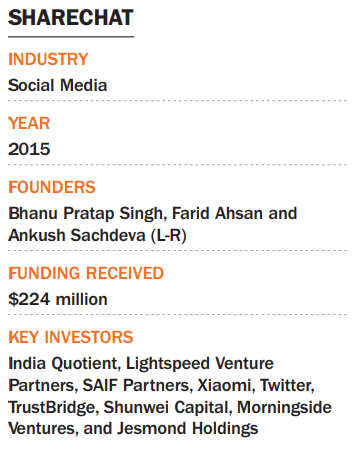
Sharechat
Shreya Paul, with over 8,000 followers, posts videos of her lip-syncing to devotional songs with a navratri filter; while Deepa, a homemaker, enjoys posting videos about her day – what she has cooked or what her kids are up to. If you sign up, your timeline will also be flooded with jokes, factoids or random forwards — some could be related to the ‘full moon’ nights. And, on Sharechat, posts related to these ‘full moon’ nights could even make it to the trending section.
“We realised the need for a space on the internet that is more accepting and inclusive, where the capability is not built around how witty you are with 140 characters in English. Instead, it is around your interests and what you do in life,” says Farid Ahsan, founder of the platform launched in 2015. Available in 15 Indian languages, ShareChat helps users discover, create and share content – on the app and on external platforms such as WhatsApp and Facebook. Ahsan says that they have carefully indexed Indian language content for their users and employed algorithms to help them ‘discover’, instead of asking them to ‘search’. Which means, their technology studies user habits and predicts what they’d like to browse, much like Instagram’s discover feature.
Sharechat’s success is evident in its growing user base, which currently stands at 60 million; about two-third of the users are aged between 18 and 30, with 70% residing in non Tier-I cities. “ShareChat defined the term ‘Indian Language Social Network’ and will continue to own it for some time to come,” says Anand Lunia of India Quotient, the early-stage investment fund that has backed it. “The team has the tech smarts and understands Indian users.”
Like most social media platforms, ShareChat is ad-led, but the founders are experimenting with commerce, influencer advertising and in-app purchases.
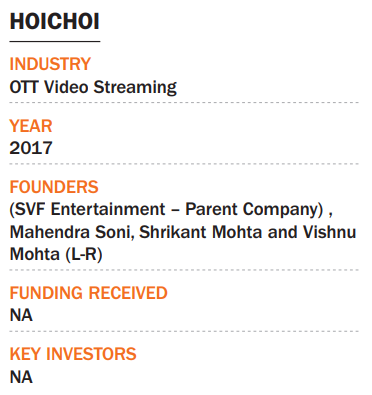
HoiChoi
With over twenty years of experience in content creation and distribution, SVF Films is a renowned production house in eastern India and has national award-winning films in its kitty. That’s exactly what they’re trying to achieve with their venture into the digital content space as well. “We realised that the Bengali audience is experimental and cerebral. The content that they love may not be liked by many other ethnicities,” says Vishnu Mohta, executive director, SVF Films and co-founder, Hoichoi. These genres could include comedy horror films or indie art films with a political rhetoric. This prompted them to launch Hoichoi as a video on-demand platform exclusively for Bengali content. “Bengali is the seventh most spoken language in the world. We have a potential audience base of over 250 million, which is a big opportunity,” says Mohta.
Literally translating to ‘fun and excitement’, the platform has 50 original shows, 10 films and an extensive content library of classic and contemporary films across genres. Ankur Pahwa, partner, EY India, says, “On platforms such as Netflix, Amazon Prime and Hotstar, the quantum of regional content is limited. Hence, regional language-focused content platforms will see huge success with users looking for specific content.”
For instance, Sohini Mitter, a Mumbai-based journalist, says that she is hooked on to Hoichoi ever since they aired Byomkesh in 2017. “Since I stay away from my hometown, this is what keeps me abreast of new films and shows.” Besides their Rs.600 annual subscription plan, Hoichoi is also experimenting with pay-per-view models along with tie-ups with telecom companies like Airtel and Vodafone.
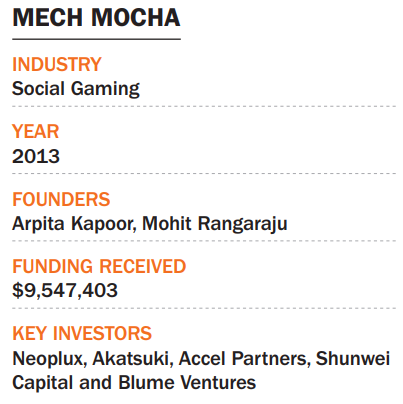
Mech Mocha
PUBG and Pokémon Go might be a rage in your city, but no one can deny that games such as ludo, snakes and ladders and UNO are evergreen! This realisation prompted Arpita Kapoor and Mohit Rangaraju to develop games for the Indian market.
Mech Mocha’s app, Hello Play, is built in seven regional languages and comprises of seven multiplayer games such as carrom, ludo, and snakes and ladders that can be played on video chat — either matched by the app or by inviting friends. “There is a natural pull for these games in the Tier II-IV cities, and our users spend over 50 million minutes per month,” says Kapoor. Users aged 18-40 make up 90% of their user base, and Mech Mocha identifies them as Pritam — after Pritam Virodhi in the film Bareilly Ki Barfi. “Our Pritams are located in tier 2-4 cities, where entertainment options are limited. For them, Hello Play is one place where he can meet new people,” says Kapoor.
“Pritam is a smart alec who wants to be cool. For him, it isn’t just about winning a game. It’s about interaction,” says Karthik Reddy, co-founder, Blume Ventures. Therefore, though the games are developed in-house, the start-up has partnered with US-based Agora.io to enhance their live, in-game voice chat. “Mech Mocha’s growth potential can be gauged from the fact that the largest consumer platforms today are built with social media embedded in the product,” points out Prayank Swaroop, partner, Accel.
To ensure she meets user needs, Kapoor logs on to the app every now and then. “My team and I ensure we play and chat with users. The notes from these calls are then shared on our internal slack channel dubbed ‘Pritam ki baatein’,” she says. Users can send invites to friends on Facebook, besides going on video mode while playing multiplayer games. Recalling one such chat that gave them an important insight, she says that a user once told her, “Arre madam ji, humne pichli baar jinke saath khela tha, unke sath dubara khelne ka mauka hi nahi milta!” That’s when the team realised that, if two like-minded people meet on the app, then they should have an option to play with each other again. Hence, they worked on the option to add friends. “We are learning new things about our users every day,” she adds.
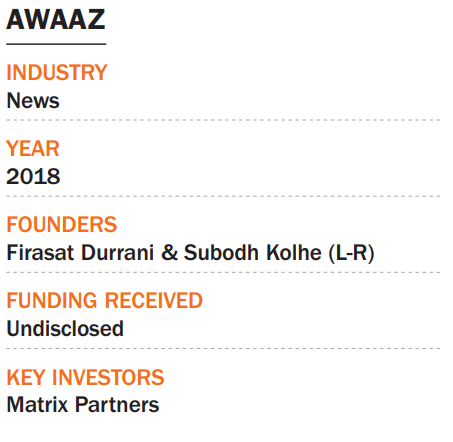
Awaaz India
Hyper-localisation is the buzzword, even when it comes to news. Wouldn’t you want to know if some house in your neighbourhood was burgled? While most households have access to news, it rarely offer in-depth coverage of local news. Yes, there are news aggregators catering to regional news, but aggregation can only offer so much. This was the gap that Subodh Kolhe and Firasat Durrani wanted to fill with Awaaz.
Founded on the pillars of ‘local language, local reporters and local news’, Awaaz is a video news app created for regional language users. “We have news on the app that might not be of interest to someone in a Tier-I city, like load-shedding in an area, specific government schemes or the latest price of vegetables at the local mandi,” says Durrani, whose app has seen 1 million downloads on Play Store in just one year. Its homescreen is divided into three tabs — content curated for the user, for the city and for the state — all original Awaaz content. The lower half of the screen also allows the user to browse through news of a specific beat.
The app is currently live in UP, Bihar, Rajasthan and Jharkhand and offers multi-media news stories in Hindi. These are uploaded on the studio app by over 400 stringers, who are paid an average of Rs.40 per story — video, images or text. While that may be quite less when compared to what other news outlets pay, the stringers are given credit on Awaaz and get to be the face of the news they break while also having the freedom to sell their stories to other outlets. After editorial moderation, the stories are published on the app and served to users based on their chosen location.
Since the success of the app hinges on the quality of content supplied by the reporters, Awaaz provides training on effective use of mobile journalism, with the likes of Umashankar Singh of NDTV, Ajit Anjum of News24 fame and Brajesh Mishra of Bharat Samachar offering their views through digital tutorials.
Sanjot Malhi, vice-president, Matrix India, says that the founding team has a good mix of technical as well as creative expertise, which is what impressed them the most about Awaaz. “News as an industry was undisrupted for a while, and as regional language audience grows, Awaaz will see a huge upside in demand,” he adds. While it’s a free app right now, the company could seek hyper-local as well as national ads to monetise its content.
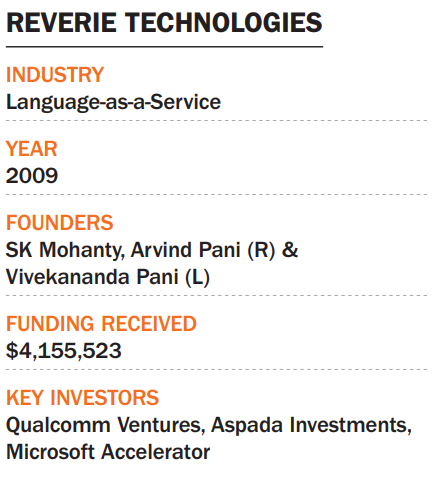
Reverie Technologies
“Let us, for a moment, take language out of the equation and see how people access content across different mediums,” says Arvind Pani, co-founder, Reverie. In print, people subscribe to magazines or newspapers in their preferred language and, this choice is also available while watching a video, TV or buying a ticket for a movie. Everyone has “equality of access”, according to Pani. However, when it comes to the digital medium, it is built largely in English. This makes it difficult for non-English speakers to access or use the medium comfortably, leading to “inequality of access or language discrimination”. And this is where Reverie Technologies steps in.
Founded in 2009, Reverie is a language technologies development company that helps businesses create content in different languages, and provides engagement and interactive layers in Indian languages. Rajnish Kumar, co-founder and CTO of ixigo, is one of their happy customers. Kumar says that they observed a significant proportion of their users are more comfortable using their mother tongue for information, search and discovery. “For instance, customers prefer to type ‘Delhi se Lucknow’ while booking their flight/train tickets,” he says, adding that the association with Reverie has helped make the app readily available to users in their native languages.
From Qualcomm as its first client, Reverie has expanded its portfolio to 30 clients across industries such as banking and financial services, state and central banks, entertainment segment and e-commerce. Ola, BHIM, Practo and eNAM are on their illustrious client list. In 2019, Reverie received Rs.1.90 billion in cash and a further Rs.770 million in investment from Reliance Industries. “Our goal is to ensure that the user experience in any Indian language is as seamless as it is in English,” says Pani.
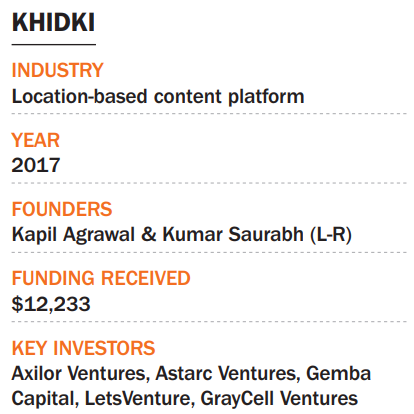
Khidki
If a local leader loses an election, a user-reporter on the location-based social media platform Khidki can post that news live on it and people within 100-kilometre radius of the reporter can log in for a discussion. Founded by Kapil Agrawal and Kumar Saurabh, this platform is currently available in 68 districts in Gujarat and Rajasthan, and provides district-level customisation in terms of content, interaction and interface.
“We have chaupals that automatically end in 72 hours,” says Saurabh. Its users, typically aged 25-35, spend about 20 minutes on the platform daily for a variety of use-cases. Besides the user-reporters who generate content, the start-up employs 200 verified professional local reporters.
Growing popularity of the app has also helped Khidki tap into local commerce. Local businesses use the platform to reach out to their target audience with the help of a feature called Live Business Show, and everyone within a certain radius can join the live stream. These businesses can showcase their products and services and interact with the customers in real time. Users can then order the product or book the service while watching the livestream in just a few taps.
Investor Axilor was convinced of its potential after meeting the team and understanding the sector the start-up was working on. “Social media behaviour was just beginning to pick up in Tier II and Tier-III cities. Subsequently, we led Khidki’s seed round in 2018,” says Venkatachalam of Axilor. Having tasted success in home markets, the founders plan to expand to 200 districts next year across Karnataka, Maharashtra and Uttar Pradesh.
Most experts agree that this is just the beginning of a massive rise in ‘localisation’ of content in a country where the dialect in every town is different from the next. Gone are the days when people took pride in being active on Facebook or Twitter. It’s the age of apps such as Sharechat, Khidki and Hello Play, where the race will be won by the desi-est of all.



